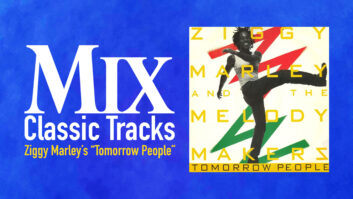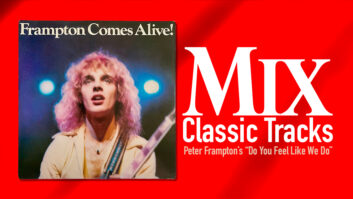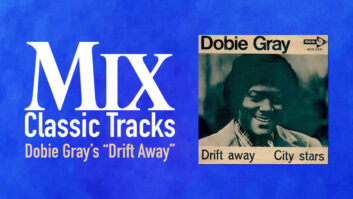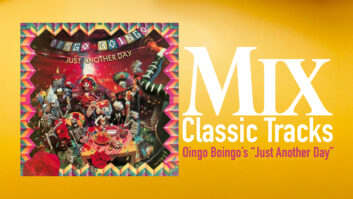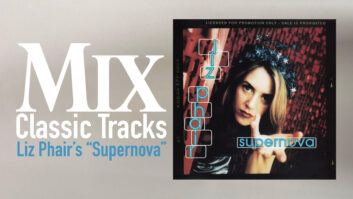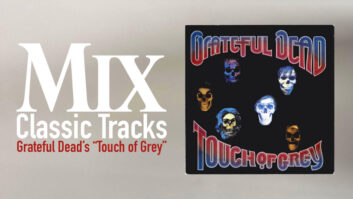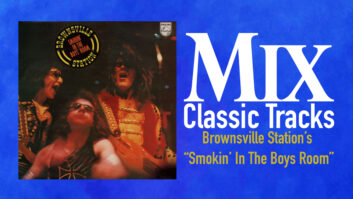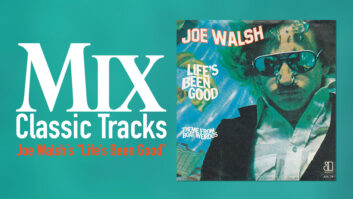The new wave movement of the mid-to late ’70s and early ’80s had such broad tentacles and encompassed so many different kinds of bands that more than two decades down the line, it’s sometimes difficult to see what united The Ramones with Graham Parker, Pere Ubu with Blondie or The Stranglers with Talking Heads. A lot of it was an attitude, of course: a dissatisfaction with the commercial status quo — which seemed to favor country rock, disco and indulgent progressive rock — coupled with the embrace of an egalitarian DIY aesthetic — anybody could be (and should be!) a rock star.
Talking Heads came from the art school wing of the new wave: Guitarist/singer David Byrne, drummer Chris Frantz and bassist Tina Weymouth met at the prestigious Rhode Island School of Design. Byrne and Frantz played in a group there called The Artistics, “who sounded like Television, only crazier and not as messianic,” Frantz once recalled in an interview. “The aesthetic,” according to Weymouth, “was called Mondo: There was a lot of black leather. The Artistics wore all black, and David had a leopard skin guitar.” Though a musician herself, Weymouth wasn’t in The Artistics, “but I went to every performance and every rehearsal. They were very loud.” The Artistics covered songs by borderline-trashy rockers like The Troggs, The Knickerbockers and Sam the Sham & The Pharaohs, and also played a smattering of odd originals, including this month’s Classic Track, “Psycho Killer,” co-written by Weymouth and Byrne. Incredibly, it was the first song Byrne ever wrote.
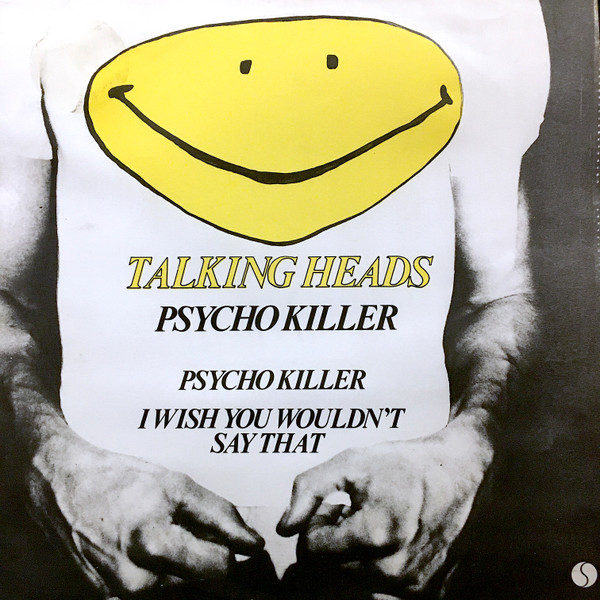
Byrne noted many years ago, “‘Psycho Killer’ was written as an exercise with someone else’s approach in mind. I had been listening to Alice Cooper — Billion Dollar Babies, I think — and I thought it was really funny stuff. I thought, ‘Hey, I can do this!’ It was sort of an experiment to see if I could write something.
“I thought I would write a song about a very dramatic subject the way [Alice Cooper] does, but from inside the person, playing down the drama. Rather than making it theatrical the way Alice Cooper would, I’d go for what’s going on inside the killer’s mind, what I imagined he might be thinking.
“I wanted it to be like Randy Newman doing Alice Cooper. One way of telling the story would be to describe everything that happens — ‘he walks across the room, he takes so many steps, he’s wearing such-and-such.’ That tells you everything that’s going on, on one level, but it doesn’t involve you emotionally. The other extreme is to describe it all as a series of sensations. I think that sometimes has more power and affects people a little stronger. It seemed a natural delusion that a psychotic killer would imagine himself as very refined and use a foreign language to talk to himself.”
The Artistics broke up in late 1974, and Byrne, Frantz and Weymouth (the latter two were boyfriend and girlfriend and later married) moved to New York and formed Talking Heads as a trio, with Weymouth playing bass. “Psycho Killer” and a couple of other Artistics’ tunes (such as Byrne’s “I’m Not in Love” and “Warning Sign”) became part of the new band’s repertoire, and after nearly half a year of rehearsal, they started gigging, primarily at lower-Manhattan’s budding punk/new wave emporium, CBGBs. The band’s first show there, in June ’75, was opening for The Ramones.
From the outset, it was clear that this band was a little…er…different. They weren’t as thrashy as their true punk brethren, but their music did have drive, a certain angularity, and a weird, undefinable pop undercurrent. Byrne was the strangest frontman imaginable — all jittery and full of nervous energy; geeky but kind of handsome; no wonder he could put across a song like “Psycho Killer.”
“I wanted to strip away the artifice of stage performance,” he explained. “Part of the idea was to use language that wasn’t being used in pop songs — everyday language, the way people talk — kind of direct, but also kind of fragmentary. And I thought the music should be as simple as you could make it and still have a song.”
Their reputation spread by word-of-mouth around New York City, and by the middle of 1976, they’d made demo tapes for Beserkley Records, Columbia Records and, at the suggestion of Lou Reed, RCA Records. Later that year, Talking Heads invited Jerry Harrison, a Harvard graduate and former member of the Boston group The Modern Lovers (led by the quirky Jonathan Richman), to play some gigs with them, and the chemistry was evident immediately. While Harrison agonized over whether to join the Heads or go to architecture school, the group signed a deal with Sire Records. In December ’76, still as a trio, they cut their first single with producers Tony Bongiovi, Lance Quinn and Tommy Ramone (nee Tom Erdelyi), and engineer Ed Stasium: “New Feeling” and “Love Goes To Building on Fire.” The following spring, the same team (minus Tommy Ramone) began work in earnest on Talking Heads debut album, 77, with Harrison joining full-time shortly after tracking began.
Sessions for the Heads’ album took place at Sundragon Studios, where The Ramones’ Leave Home was also cut. “It was a wacky joint,” remembers engineer Stasium, a New Jersey native (like Bongiovi) who had been working at Le Studio Morin Heights in Quebec for a year before returning to New York area in August 1976. “I think Tony’s the one who found Sundragon. He was working at Media Sound, but he had already started his search for the building that would become Power Station. Sundragon was this odd little place on 20th Street between 5th and 6th Avenues. It was basically a jingle place owned by a fellow named Ned Lieben and his partner, Michael Ewing. It was in a loft and they both lived in the loft, which was on the eighth floor and this building had the slowest elevator in New York City. The elevator was this tiny thing, maybe four-by-four, and the more equipment and more people you tried to cram into it, the slower it went. It was unbelievable! There was this huge locked door right on the other side of the elevator, so you couldn’t just zip out of the elevator — you had to ring the bell, wait for someone to answer, and they’d come answer and then you could get out of the elevator, holding the elevator door open as you dragged the equipment out.
“Then, as you walked past Michael’s bedroom, which was on the left-hand side facing 20th Street, you’d always be overwhelmed by the smell of pot smoke. Later, he went into real estate and made millions of bucks. There was a little equipment room with an EMT plate and a few other things, then you’d go through a door and then you were in the studio itself, which was really tiny — probably about 15 feet across and 30 feet wide with maybe a nine or 10-foot ceiling — and it was really dead: carpeted and blanketed, very 1970s. There was a separate, very small control room; you couldn’t fit more than two or three people in there. If you walked through the studio, then you were in the kitchen, which is where the tape storage was, and then you’d be in the part where Ned lived, which is where the tape storage was. The other unusual thing about this place is that on one wall, there was this huge aquarium — it had to be 10 feet long and four feet wide. So it was kind of strange, but it ended up being a pretty good place to make records.
“The control room had a Roger Mayer custom-made console,” Stasium continues. “He’s the guy who had built a lot of Hendrix’s electronics, including the first phaser ever made. It was a really good-sounding board. It had some compressors built into it; it was transformerless and the clarity was unbelievable on that Talking Heads record — the top end is marvelous. It couldn’t have been more than 20 inputs; maybe 3-band EQ, I don’t remember exactly. The studio also had a nice-sounding Studer A-80 16-track machine and one of the old Studer remotes. Later, they got a 24-track, but we did The Ramones and Talking Heads on the 16-track.
“I think we cut most of the tracks before Jerry was in the group. We did most of it as a trio, and then all of a sudden, Jerry was there. We cut everything live. We made big boxes for the amplifiers out of these huge pieces of foam rubber and blankets to prevent leakage into the drum mics. Chris [Frantz] was in the corner, on the far side of the room, with his drum kit. David would always do a scratch vocal, but we redid all of the vocals later.”
Asked if Byrne’s offstage personality was at all similar to his onstage persona, Stasium says, “He was just about the same — a very quirky fella. It’s funny, he didn’t want Tony Bongiovi in the control room when he was doing his vocals; I’m not exactly sure why. Knowing Tony, though, he was probably trying to tell him how to sing, or give him some ‘emotional guidance,’” he adds with a laugh.
Classic Tracks: Talking Heads’ “Road to Nowhere”
As for the miking scheme on the sessions, “I’m sure the drums were the old standards — 57 on the snare, 421s on the toms, 421 on the kick, 451 on the hi-hat, 87s on overheads,” Stasium says. “There were no room mics because there was no room for them. On the guitar amp, it was probably a 57 and an 87 in various positions.
“I know we did some overdubs at ODO Studios, too. I remember doing all of the percussion there with Jimmy Maelen, who was one of the top players in town and a great guy; he worked with everyone.”
Mixing was at Media Sound on the Studio A Neve 8078 console. “Because Sundragon was so tiny, there was no ambiance there, so what I did for mixing at Media — not for all the songs, but I do remember it for ‘Psycho Killer’ — is I pumped the drums back into the big room at Media and miked them — just cranked them through some Crown DC-300s or something, brought them back up through some mic inputs and went back live into the mix. It gave it a nice punch.”
It was also during the mix process that the bass intro for “Psycho Killer” was lengthened (the old-fashioned way — by splicing), and Stasium also recalls having some input on the instrumental ending: “I always put my two cents in,” Stasium says. “Originally, the ending went on and didn’t really do anything — there was none of the feedback; it needed more excitement. So I suggested putting the power chords on, and then I remember saying to David, ‘Just do a wild thing, like the solo in “I Can See For Miles.”’ And he went, ‘Huh? What’s that?’ He didn’t know The Who or Pete Townshend. I’m saying, ‘Let’s get some feedback and go crazy on the end!’ So that was inspired by me telling David to imitate a solo he’d never heard. I probably even picked up a guitar and demonstrated it. David was mostly using a Gibson then, but I think there’s some Strat on there as well. Tina was definitely using her Mustang bass.”
There were actually two versions of “Psycho Killer”: the electric version that appears on the album, and an acoustic version that used most of the same basic tracks, but also had overdubbed acoustic guitars (by Byrne) and cello (by Ernie Brooks of the Modern Lovers). The latter came out as the B-side to “Psycho Killer,” released in January 1978. (And the version that opens the extraordinary Talking Heads concert film Stop Making Sense is like a hybrid: It has Byrne on acoustic guitar playing to some pre-recorded tracks.)
https://youtu.be/bM9SHDNAbPw
Talking Heads were never really a singles band, of course. “Psycho Killer” only made it to Number 92 on the Billboard Hot 100, but the song was an FM/college radio favorite almost immediately, and it really helped establish the group outside of New York. Today, “Psycho Killer” is one of a dozen or more Talking Heads songs that can be rightfully regarded as true rock classics (and eventual fodder for this column). The band would undergo tremendous transformations over the next several years after this fantastic debut, as their sound matured and took on exciting new dimensions with the addition of various ethnic and avant-garde shadings. The group never made a bad album, and most are downright brilliant. There’s no question, though, that there is a rawness and innocence on 77 that the group never quite recaptured. It’s the sound of a band learning about who they are: American originals.
